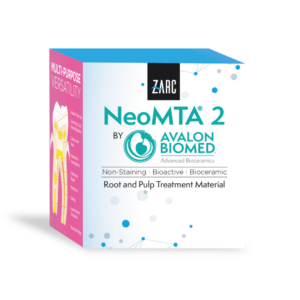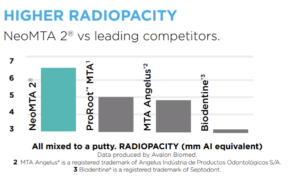NeoMTA 2
Promotes hydroxyapatite formation.
NeoMTA 2
Bioceramic restorative sealer
Promotes hydroxyapatite formation.


Biocompatible

Easy to mix

Non-stainning

Radiopaque

-
NeoMTA 2 is biocompatible and promotes hydroxiapatite formation to seal and facilitate healing.
-
Bioceramic repair material. For highly versatile root and pulp treatment of second generation with improved characteristics.
-
Bioactive. To minimize reaction to foreign bodies and support healing. Biocompatible, non-cytotoxic, non-genotoxic.
-
Resin-free. For maximum bioactivity and biocompatibility.
-
Its composition has been improved in order to facilitate mixing.
-
Patented gel. Permit mix it getting a thick putty, with optimal handling for any application.
-
Resistence to immediate washing. When the putty is mixed, it stays where you want it, so you can complete the procedure efficiently.
-
The sealer is whiter and does not leave visible stains on the teeth.
-
High pH. Antibacterial and promotes the osteogenic response.
-
No stains. For optimal aesthetics, it will not discolor the teeth.
-
NeoMTA 2 is radiopacic to facilitate identification in X-ray.
-
Dimensionally stable. To ensure a complete seal without gaps, minimizing the possibility of bacterial infiltration.
-
Ostegenic. It promotes the formation of hydroxyapatite on the surface to seal and support healing through the release of calcium and hydroxide ions.
Indications:
- Direct and indirect pulp cap
- Partial pulpotomy
- Cavity liner and base
- Pulpotomy and apexogenesis
- Perforation repair
- Root resorption
- Obturation
- Root apexification
- Root-end filling
- Working and setting time: 14 minutes
Mechanism of action
After MTA is placed on the tooth, the body fluids infiltrate the paste to cause setting. During the process, calcium and hydroxide ions are released from the MTA, promoting the formation of hydroxyapatite (HA) on the surface of the MTA. When MTA coats the surface, it hides the underlying MTA to minimize foreign bode reactions and support pulp or periapical tissue healing responses.

High radiopacity
It contais tantalum oxide as a radiopaque agent. Tantalum oxide has a higher atomic number that provides a higher radiopacity than the more commonly used zirconium oxide.







